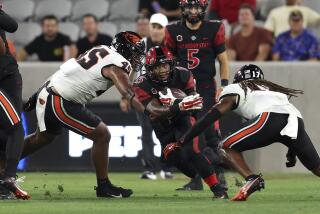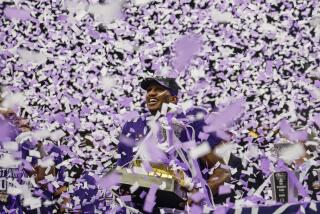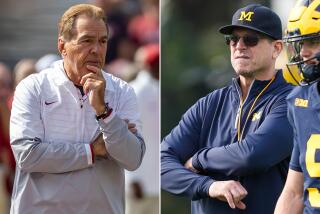Pacific 12 Conference likes its show despite holes in the marquee
- Share via
Hollywood loves a feel-good story, so it makes sense that Pacific 12 Conference officials have chosen the Fox Studio lot for their annual football media day.
Commissioner Larry Scott can stand before the cameras on Tuesday morning and talk about a record-setting $3-billion television deal. He can remind everyone about bringing Colorado and Utah into the fold and establishing a conference championship game.
“I feel very good about the last year,” Scott said. “There’s just a lot that is exciting.”
But the silver lining comes with a few dark clouds — and they loom directly over the Pac-12’s marquee football programs.
With USC entering a second season under an NCAA bowl ban and Oregon embroiled in controversy over payments to a recruiting service, the inaugural title game might have to settle for the conference’s third- and fourth-best teams.
“I don’t think anyone would say it’s an ideal situation,” said Paul Swangard, managing director of the Warsaw Sports Marketing Center at Oregon. “When your product is in question, it certainly creates a challenge.”
And that’s where bad news edges in on Scott’s otherwise sunny message. “No one likes a cloud of accusations and questions about integrity,” he said. “That’s not the Pac-12 brand.”
The NCAA is investigating Oregon for a $25,000 payment to Willie Lyles, a Houston-based talent scout.
Football programs often rely on scouts to evaluate high school prospects, but it turned out that Lyles provided little in the way of useful information. He did, however, have close ties to a top recruit, Lache Seastrunk, who ultimately signed with the Ducks.
If Oregon is found to have paid Lyles to help secure Seastrunk’s commitment, that could constitute an NCAA violation. Athletic department officials have repeatedly declined to comment.
“It’s an awkward time because nothing is coming out of the Oregon camp other than news of them hiring expensive attorneys,” Swangard said.
Although no wrongdoing has been proved, the controversy — along with USC’s unsuccessful appeal of NCAA penalties stemming from the Reggie Bush scandal — has cast the Pac-12 in a bad light.
As for the potential matchup in December’s title game, Scott chose not to look that far ahead, saying: “That’s hypothetical, getting way out in front.”
Marketing experts believe the commissioner is better off focusing on all that has gone right for his conference.
“One basic rule of public relations, you’re always looking for things that bring attention to your brand,” said George Belch, a professor at San Diego State’s MBA sports management program. “I would think the conference will really be playing up the addition of two new teams and all the big changes.”
Although Scott failed to lure Texas into a proposed super-conference, he has created a stir with other moves.
The former pro tennis executive was hired in July 2009 — more than year before the conference’s previous broadcast deal expired — which gave him time to launch a marketing blitz aimed at raising the Pac-12’s national profile.
There was a bicoastal media tour and a slick video celebrating the expansion. Scott hired the high-powered Creative Artists Agency as a consultant and assembled a staff that included marketing expert Danette Leighton and former Big 12 commissioner Kevin Weiberg.
“He brought professional-grade business practices to amateur sports,” said AJ Maestas of Navigate Marketing, a Chicago-based firm. “He started to push the envelope.”
During the television negotiations, the Pac-12 relied heavily on CAA and persuaded ESPN and Fox to up the ante in a joint effort. The resulting 12-year deal is worth about $225 million to the league annually.
That’s almost four times the amount of the previous contract and slightly more than the Southeastern Conference ($205 million) and Big Ten ($220 million) are getting from their broadcasters each year.
“The Pac-12 should not be where it is,” Maestas said. “They’re outperforming their natural order.”
The deal looks even better because the conference was able to retain the rights to enough content — especially in football and men’s basketball — to stock its own broadcast and digital networks set to launch next year.
And the membership is happy because of Scott’s insistence on revenue sharing.
“We move away from an era when the Los Angeles schools got a bigger piece of pie,” Swangard said. “Now there is a model where each of the schools benefit . . . it elevates everybody.”
The Oregon professor and others believe there is enough good news to balance, if not outweigh, the negative. They also suspect that attention will shift to the field once games begin.
“Fans are pretty amazing in what they focus on and how forgiving they can be,” Belch said.
They will be watching to see if Oregon can repeat last season’s run to the Bowl Championship Series championship game and if Utah can make the transition from the Mountain West to a higher level of competition from week to week.
They will be keeping an eye on Stanford quarterback Andrew Luck, an early Heisman Trophy candidate.
That should leave Scott enough of an opening to remain largely positive. The commissioner foresees a happy ending to his script.
“In many respects, I believe we’re only at the beginning,” he said. “The next year is going to be just as exciting.”
twitter.com/LATimesWharton
More to Read
Go beyond the scoreboard
Get the latest on L.A.'s teams in the daily Sports Report newsletter.
You may occasionally receive promotional content from the Los Angeles Times.










